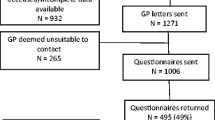Abstract
Purpose
Promoting physical activity among cancer survivors is a high priority. Understanding barriers to physical activity provides an evidence base to inform relevant strategies for doing so.
Methods
Telephone interviews were conducted with colorectal cancer survivors at 5 (n = 538) and 12 months post-diagnosis (n = 403). We used an ecological model of health behaviour to classify participants’ perceived barriers to physical activity into four sub-categories: physical environment, social environment, personal attributes, and disease-specific barriers.
Results
Disease-specific barriers were perceived as the greatest challenge to colorectal cancer survivors being more physically active, closely followed by personal attributes. The physical environment presented the least salient perceived barriers; however, the physical environment was most closely associated with achieving sufficient levels of physical activity at 5 months post-diagnosis. The difficulties most frequently reported by participants at both time points were belief that they were already active enough, not feeling well enough to be physically active, and experiencing fatigue.
Conclusions
These findings suggest potential points for intervention to influence physical activity among colorectal cancer survivors.
Similar content being viewed by others
References
Courneya K (2003) Exercise in cancer survivors: an overview of research. Med Sci Sports Exerc 35:1846–1852
Segal R, Reid R, Courneya K et al (2003) Resistance exercise in men receiving adnrogen deprivation therapy for prostate cancer. J Clin Oncol 21:1653–1659
Dimeo F, Stieglitz R, Novelli-Fischer U et al (1999) Effects of physical activity on the fatigue and psychologic status of cancer patients during chemotherapy. Cancer 85:2273–2277
Lynch B, Cerin E, Newman B et al (2007) Physical activity, activity change, and their correlates in a population-based sample of colorectal cancer survivors. Annals Behav Med 34:135–143
Demark-Wahnefried W, Peterson B, McBride C et al (2000) Current health behaviors and readiness to pursue life-style changes among men and women diagnosed with early stage prostate and breast carcinomas. Cancer 88:674–684
Jones L, Courneya K (2002) Exercise counseling and programming preferences of cancer survivors. Cancer Pract 10:208–215
Demark-Wahnefried W, Aziz N, Rowland J et al (2005) Riding the crest of the teachable moment: promoting long-term health after the diagnosis of cancer. J Clin Oncol 23:5814–5830
Courneya K, Friedenreich C, Quinney H et al (2005) A longitudinal study of exercise barriers in colorectal cancer survivors participating in a randomized controlled trial. Annals Behav Med 29:147–153
Sallis JF, Owen N, Fisher EB (2008) Ecological models of health behavior. In: Glanz K, Rimer BK, Viswanath K (eds) Health behavior and health education: theory, research, and practice, 4th edn. Jossey-Bass, San Francisco, pp 465–482
Department of Health and Aged Care (1999) National physical activity guidelines for Australians. Australian Government, Canberra
Meyerhardt J, Heseltine D, Niedzwiecki D et al (2006) Impact of physical activity on cancer recurrence and survival in patients with stage III colon cancer: findings from CALGB 89803. J Clin Oncol 24:3535–3541
Ball K, Owen N, Salmon J et al (2001) Associations of physical activity with body weight and fat in men and women. Int J Obes 25:914–919
Sallis J, Saelens B (2000) Assessment of physical activity by self-report: status, limitations, and future directions. Res Q Exerc Sport 71:1–14
Centers for Disease Control and Prevention (2007) Barriers to being active quiz. http://www.cdc.gov/nccdphp/dnpa/physical/life/barriers_quiz.pdf
Napolitano M, Marcus B (2000) Breaking barriers to increased physical activity. Phys Sportsmed 28:1–3
Humpel N, Owen N, Iverson D et al (2004) Perceived environment attributes, residential location, and walking for particular purposes. Am J Prev Med 26:119–125
Humpel N, Marshall A, Leslie E et al (2004) Changes in neighborhood walking are related to changes in perceptions of environmental attributes. Annals Behav Med 27:60–67
Leddy S (1997) Incentives and barriers to exercise in women with a history of breast cancer. Oncol Nurs Forum 24:885–890
Courneya K, Friedenreich C (1997) Determinants of exercise during colorectal cancer treatment: an application of the theory of planned behavior. Oncol Nurs Forum 24:1715–1723
Courneya K, Friedenreich C, Arthur K et al (1999) Understanding exercise motivation in colorectal cancer patients: a prospective study using the theory of planned behavior. Rehabil Psychol 44:68–84
Booth M, Bauman A, Owen N (2002) Perceived barriers to physical activity among older Australians. J Aging Phys Act 10:271–280
Cooper H (1995) The role of physical activity in the recovery from breast cancer. Melpomene J 14:18–20
Cohen-Mansfield J, Marx M, Guralnik J (2003) Motivators and barriers to exercise in an older community-dwelling population. J Aging Phys Act 11:242–253
Lim K, Taylor L (2005) Factors associated with physical activity among older people: a population-based study. Prev Med 40:33–40
Schwartz A (1998) Patterns of exercise and fatigue in physically active cancer survivors. Oncol Nurs Forum 25:485–491
Acknowledgements
The authors would like to thank Mr. Kyle Blackwell and Associate Professor Elizabeth Eakin for their assistance in developing the barriers to physical activity scale used in this study. The study was funded by Cancer Council Queensland.
Author information
Authors and Affiliations
Corresponding author
Rights and permissions
About this article
Cite this article
Lynch, B.M., Owen, N., Hawkes, A.L. et al. Perceived barriers to physical activity for colorectal cancer survivors. Support Care Cancer 18, 729–734 (2010). https://doi.org/10.1007/s00520-009-0705-4
Received:
Accepted:
Published:
Issue Date:
DOI: https://doi.org/10.1007/s00520-009-0705-4




